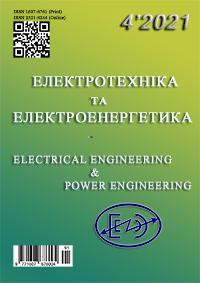Magnetic field of current transformer
DOI:
https://doi.org/10.15588/1607-6761-2021-4-1Keywords:
current transformer, a magnetic field, vector diagram, equivalent circuit, leakage flux, main magnetic flux, free part of the magnetic circuit, criterion of non-uniformity of magnetic flux distribution, current and angular errors of the transformerAbstract
Purpose. Development of equivalent circuits based on a detailed analysis of the magnetic field distribution in asymmetric CT structures and drawing up a mathematical model for calculating errors in relation to a multi-range built-in CT with a toroidal MC and a single-turn primary winding with different filling of the MC with turns of the secondary winding.
Methodology. Experimental study of the magnetic field distribution in a toroidal current transformer and transformer errors
Findings. The equivalent circuits of the current transformer, which adequately reflect the distribution of the magnetic field in the magnetic circuit of the transformer and a mathematical model for calculating the errors, were developed.
Originality. Based on the results of modeling in FEMM and experimental studies, the nature of the distribution of the magnetic field with partial filling of the magnetic circuit with turns of the secondary winding was determined, and equivalent circuits of the current transformer were developed.
Practical value. A mathematical model was developed for calculating the distribution of the magnetic field in the magnetic circuit and the transformer errors, on the basis of which a program for calculating the errors of current transformers was compiled.
References
Shevchenko,V.P., Babiychuk O.B. (2008). ledo-vanie magnitnogo polya transformatora toka. El-ektromashinostroenie i elektrooborudovanie, No 70, 91-94.
Shevchenko, V.P., Babiychuk, O.B. (2008). Issle-dovanie magnitnogo polya transformatora toka. Elektromashinostroenie i elektrooborudovanie. No 70, 91-4.
Brandiski, K., Yacheva, I. (2002) CAD sistemi v elektromagnetizma. Rukovodstvo za QuickField i FEMM. SIELA, 243.
Shevchenko, V.P. (2017) Paket programm proek-tirovaniya i analiza transformatorov toka. 155.
Shevchenko, V. (2005). Heightened the precision of current transformers. Proceedings of XIV-th In-ternational Symposium SIELA, Bulgaria. Vol. 1, 123-127.
Kuzhekov, S.L., Degtyarev, A.A. (2015) Ma-tematicheskoe modelirovanie transformatorov to-ka v rezhimah s glubokim nasyischeniem mag-nitoprovodov Sigre, 8.
Pristup, A.G., Chervyakov, A.V. (2012) Modeliro-vanie magnitnyih poley v programme FEMM: ucheb.-metod. Posobie. Novosibirsk: Izd-vо NGTU, 92.
Usachev, A.E., Mullin, F.F. (2004) Sistematiches-kie pogreshnosti izmeritelnyih transformatorov to-ka: Zavisimost ot velichinyi pervichnogo toka. Problemyi energetiki, 7-8, 35-40.
Branchi, N. (2005) Electrical machine analysis using finite elements. Taylor & Fremeis Group, 275.
Colonel Wm. T. McLyman (2011) Transformers and Inductor Design Handbook. Forth Edition. Taylor and Francis Group, 669.
Jay Andersen Current Transformers Theory & Testing. Omicron Academy, 2016, 54.
Steve Laslo Current Transformers. (2013) Bonne-ville Power Administration. Revision 1.2, 142.
Edvard Csanyi The Essentials Of Current Trans-formers In Power Circuits (Theory and Practice), Electrical Engineering Portal, December, 3rd 2018.
Heathcote Martin J. J & P Transformer Book 13th Edition. Elsevier Ltd., 2007. XIV, 974.
Werner D.H., Kwon D.-H. (eds.) (2014) Transfor-mation Electromagnetics and Metamaterials: Fundamental Principles and Applications. Spring-er, 499.
Hurley, W.G., Wölfle, W.H. (2013) Transformers and Inductors for Power Electronics: Theory, De-sign and Applications. John Wiley & Sons Ltd., 360.
Poularikas, A.D. (2010) The Transforms and Ap-plications Handbook. IEEE Press, 914.
Downloads
Published
How to Cite
Issue
Section
License
Copyright (c) 2021 Volodymyr Shevchenko, Olga Babiychuk

This work is licensed under a Creative Commons Attribution 4.0 International License.
Creative Commons Licensing Notifications in the Copyright Notices
Authors who publish with this journal agree to the following terms:
Authors retain copyright and grant the journal right of first publication with the work simultaneously licensed under aCreative Commons Attribution License that allows others to share the work with an acknowledgement of the work's authorship and initial publication in this journal.
Authors are able to enter into separate, additional contractual arrangements for the non-exclusive distribution of the journal's published version of the work (e.g., post it to an institutional repository or publish it in a book), with an acknowledgement of its initial publication in this journal.
Authors are permitted and encouraged to post their work online (e.g., in institutional repositories or on their website) prior to and during the submission process, as it can lead to productive exchanges, as well as earlier and greater citation of published work.

